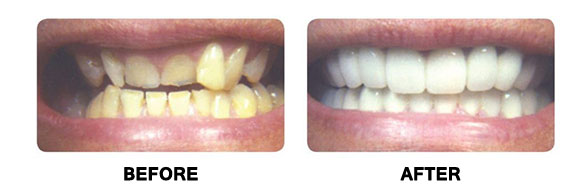Did you know that the same dental material used for tooth-colored fillings can be used for cosmetic dental treatments? Dental composite resin is often used for composite fillings, but can also be used for a procedure called dental bonding. Dental bonding is a cosmetic dental procedure that bonds composite resin to the tooth in order to repair damage, improve color, change its size or shape, and to fill gaps between teeth. Since dental bonding is not as well known as other cosmetic dentistry treatments, here are five facts about dental bonding:

In some cases, dental bonding can be used to fabricate composite veneers. Just like traditional veneers, composite veneers can improve the size, shape, color, alignment, and spacing of your teeth. They can also be used to restore a single tooth or multiple teeth. Unlike porcelain veneers, however, composite veneers do not require the removal of enamel for their placement, making the treatment reversible. This also means that they do not last as long as porcelain veneers.
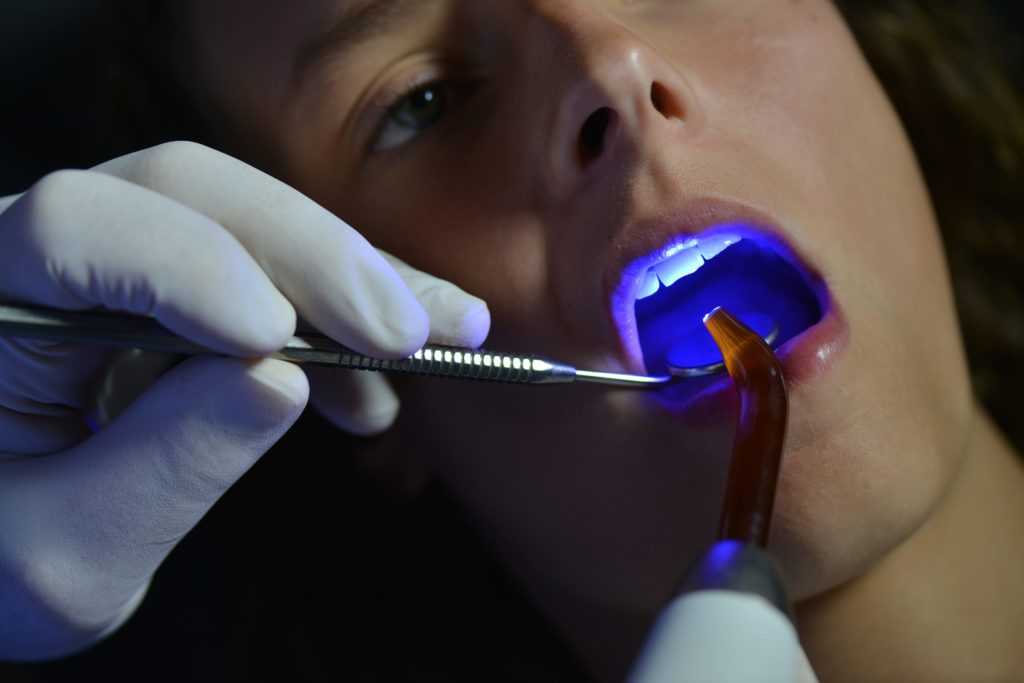

In most cases, dental bonding can be applied without needing to alter the natural tooth structure in anyway. Since composite resin is bonded to the exterior of your tooth, there is often no need for dental anesthetics during dental bonding treatment. During dental bonding treatment, the composite resin is applied and hardened with a curing light layer by layer. The final layer will then be shaped and polished to match the natural tooth structure.

Out of all the various options available for cosmetic dental treatments, dental bonding is one of the most affordable cosmetic dental treatments. One reason for its affordability is that it is considered a direct restoration. Direct restorations can be entirely performed without the need for a dental laboratory. This means that the normal fees charged by a dental lab are waived, so the overall treatment cost is lower. However, the total cost of dental bonding will depend on the individual procedure.

Dental bonding is not associated with any major risks because there is no enamel modification or invasive treatments. It can also be easily reversed, so any problems can be solved by its removal. For this reason, many people opt for dental bonding until they are ready to commit to more permanent forms of cosmetic treatment.

Although dental bonding may not last as long as other cosmetic dental methods, it is still exceptionally durable. If properly cared for, dental bonding can last about 5-7 years. To preserve the results of dental bonding, it is recommended to avoid chewing extremely hard foods, as well as teeth grinding or clenching. Twice daily brushings, daily flossing, and regular dental appointments are also essential to maintaining this type of restoration.
Overall dental bonding can offer similar results to veneers with a treatment that is comfortable, affordable, durable, and has no significant risks. Dental bonding is an ideal treatment for those who are interested in seeing how cosmetic dentistry can help their smile, without needing to commit to costly or lengthy cosmetic procedures. If this sounds like you, then dental bonding may be the perfect cosmetic dental treatment for you. For more information, see “Dental Bonding”.

Dr. Anthony Mancino is Monmouth and Ocean County New Jersey’s General and Cosmetic Dentist and has been practicing for over 25 years focusing on cosmetic and overall dental health at his Wall, NJ practice. Dr. Mancino is a graduate of Villanova University and University of Pennsylvania. He is also a member of the American Dental Association, New Jersey Dental Association, Monmouth & Ocean County Dental Association, American Academy of Cosmetic Dentistry, and the Academy of General Dentistry.
Are there things about your smile you wish you could change? Have old injuries or dental habits caused your teeth to have a lackluster appearance? Is it time for you to reinvent yourself through a new smile? If so, then it may be time for you to get a smile makeover.
Smile makeovers are becoming increasingly possible in cosmetic dentistry. Just as the name suggests, a smile makeover will completely change the appearance of your smile for the better. Depending on your aesthetic goals, smile makeovers can address issues such as:
Additionally, smile makeovers can vary from patient to patient. In some cases, all cosmetic concerns can be corrected with a single cosmetic treatment, while others may require multiple treatments to obtain the best results. If you are considering a smile makeover, here are five different smile makeover options:


Teeth whitening is the most popular cosmetic dental treatment because it is easy, quick, and effective. Whitening procedures can be completed in one dental visit and results are almost immediately visible. During whitening procedures, a whitening agent is applied to the teeth and left for 30-60 minutes. Although it is rinsed off, the whitening agent will continue to work for the next 24 hours. The main downside of teeth whitening for a smile makeover is the fact that it only treats discolored teeth. Because of this, it may work best as a secondary treatment.

Following teeth whitening, porcelain veneers are another highly popular cosmetic dental treatment. Porcelain veneers are thin porcelain shells that are adhered to the front surface of visible teeth in order to correct their color, size, shape, spacing, and alignment. Their versatility is one of the reasons for their popularity. However, dental veneers require that a tiny layer of tooth enamel is removed for their placement. This makes them an irreversible treatment. On average, porcelain veneers can last 10-15 years after their initial placement.

Composite bonding uses dental composite resin to correct minor structural and spacing issues. In some cases, veneers can be made from composite. These generally do not require enamel removal for placement, but they only last half as long. Composite bonding is also commonly used to repair chips or cracks, as well as to fill small gaps between teeth. Composite bonding is valued for its affordability, however it lacks the longevity of other cosmetic treatments.

Dental implants are artificial tooth roots that are used to replace missing teeth. With dental implants, a titanium implant screw is placed in the jawbone with a connector piece protruding out of the gums. Eventually, a dental crown will be adhered to the connector piece to fill in the gap left by a missing tooth. In some cases, an implant-supported bridge can also be used to fill in gaps left by multiple missing teeth. Dental implants are valued for their aesthetic appeal, extreme strength, and longevity.


Implant-supported dentures are used to restore an entire arch of teeth that are severely decayed, damaged, or missing. They can be used for the upper or lower arches, as well as for both if needed. They are composed of an acrylic or resin denture that is fixed in the mouth by 4-6 dental implants per arch. Implant-supported dentures are considered to be the best option for full mouth reconstruction cases because they offer the benefits of dentures along with the benefits of dental implants. For more information, see “Why Implant-Supported Dentures May Be Right For You”.
As you can see, there are a variety of smile makeover options available. Depending on your individual case and aesthetic goals, teeth whitening, porcelain veneers, composite bonding, dental implants, or implant-supported dentures may be the best cosmetic dental treatment for you. Ultimately, however, only a cosmetic dentist can evaluate your case and help you determine the best smile makeover treatment for your needs.

Dr. Anthony Mancino is Monmouth and Ocean County New Jersey’s General and Cosmetic Dentist and has been practicing for over 25 years focusing on cosmetic and overall dental health. Dr. Mancino is a graduate of Villanova University and University of Pennsylvania. He is also a member of the American Dental Association, New Jersey Dental Association, Monmouth & Ocean County Dental Association, American Academy of Cosmetic Dentistry, and the Academy of General Dentistry.
Last week we looked at the first five reasons why dental implants are the best restorative treatment. Here are five more:

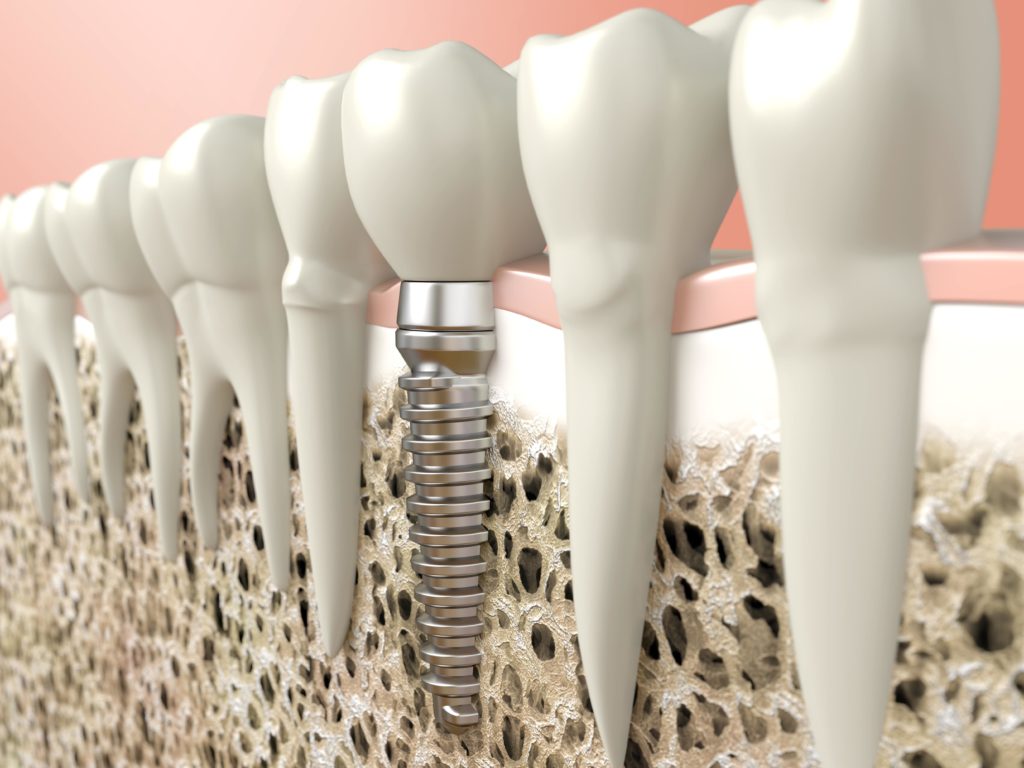
After dental implants are placed in the jaw, they undergo a process called osseointegration. This is the process of the implant fusing to the surrounding bone, which takes about 3-6 months to complete. To function properly, osseointegration must occur during the healing process. No other restoration method is capable of fusing to the jawbone, and this is one of the main things that sets dental implants apart.

Dental implants are the only restorative method that can mimic natural tooth roots. Unfortunately, when teeth are lost, the jawbone no longer receives stimulation from the forces of chewing and biting. When this happens, the body will naturally start breaking down the calcium in the bone to use it elsewhere in the body. Since dental implants mimic tooth roots, they provide the jawbone with the stimulation necessary to preserve bone mass. This also means that your facial structure will not change over time like with dentures.

Another benefit of having dental implants implanted into the jawbone is their strength and longevity. When the surrounding bone fuses around them, it effectively secures the dental implants in place. This means that the implant should not loosen as the result of normal chewing, biting, and speaking functions. Additionally, this also means that dental implants will last much longer than other types of dental restorations. On average, dental implants can last 10-15 years, but some have even lasted 20 years.
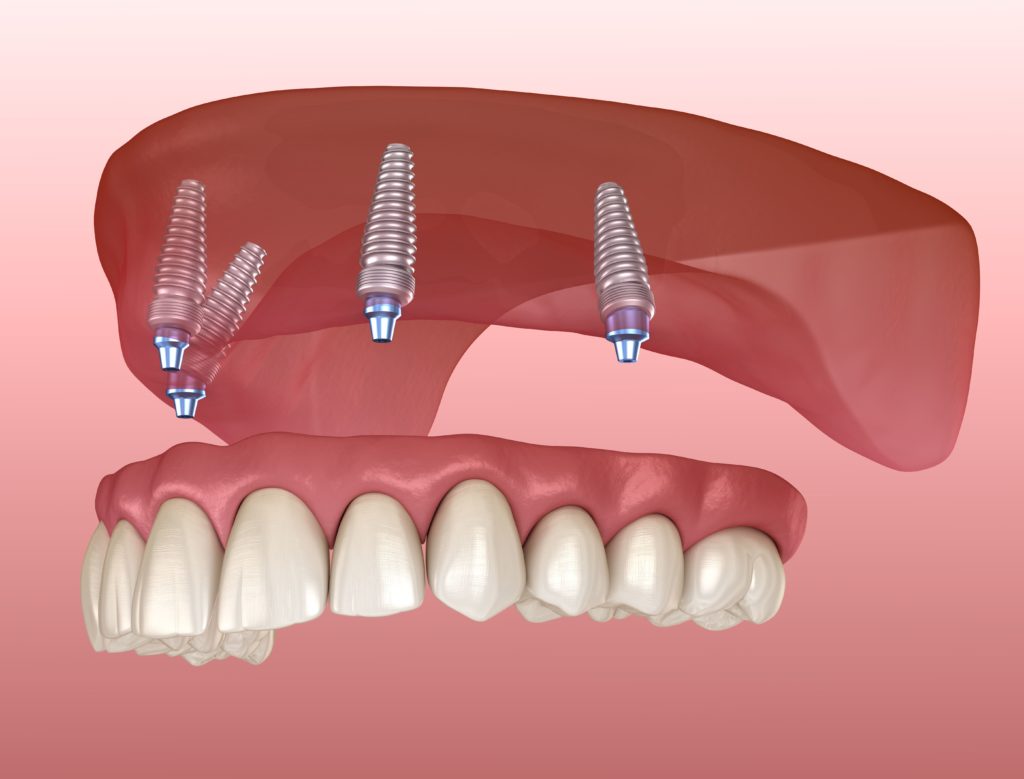

Dental implants can also offer a variety of dental treatments for patients with different treatment goals. For example, a single missing tooth can be restored using an implant supported dental crown. In cases where multiple adjacent teeth are missing, an implant supported bridge can be used. Finally, in cases where an entire mouth reconstruction is needed, an implant supported denture can be used on the top and bottom arches.

One of the final reasons are that dental implants can restore the greatest amount of natural function when compared to other restoration methods. This is because their strength makes them more resistant and prevents them from coming loose when dealing with the stress of chewing or biting. Additionally, dental implants have a highly natural appearance and many people won’t be able to tell that you have an implant instead of a natural tooth.
As you can see, dental implants are truly a remarkable modern dental advancement for restoring decayed, damaged, or missing teeth. Reasons #1-5 evaluated their coordinating dental prosthesis, types, size, structure, and how they are placed. Reasons #6-10 focused on their ability to fuse with the jawbone and how this results in the preservation of bone mass, their strength and longevity, treatment versatility, and their natural appearance and function. Surely, these ten reasons show why dental implants are the best restorative treatment for the 120 million Americans missing teeth.

Dr. Anthony Mancino is Monmouth and Ocean County New Jersey’s General and Cosmetic Dentist and has been practicing for over 25 years focusing on cosmetic and overall dental health. Dr. Mancino is a graduate of Villanova University and University of Pennsylvania. He is also a member of the American Dental Association, New Jersey Dental Association, Monmouth & Ocean County Dental Association, American Academy of Cosmetic Dentistry, and the Academy of General Dentistry.
Are you one of the 120 million Americans that is missing a tooth? Are your decayed or damaged teeth putting you closer to joining the missing tooth group? Do not fear! Just because you are currently or soon to be missing a tooth, doesn’t mean you have to live with a hole in your mouth forever. Thanks to dental implants, you can restore both the function and look of your tooth. In fact, dental implants are viewed by dentists as one of the best restorative treatments. Here are ten reasons why:
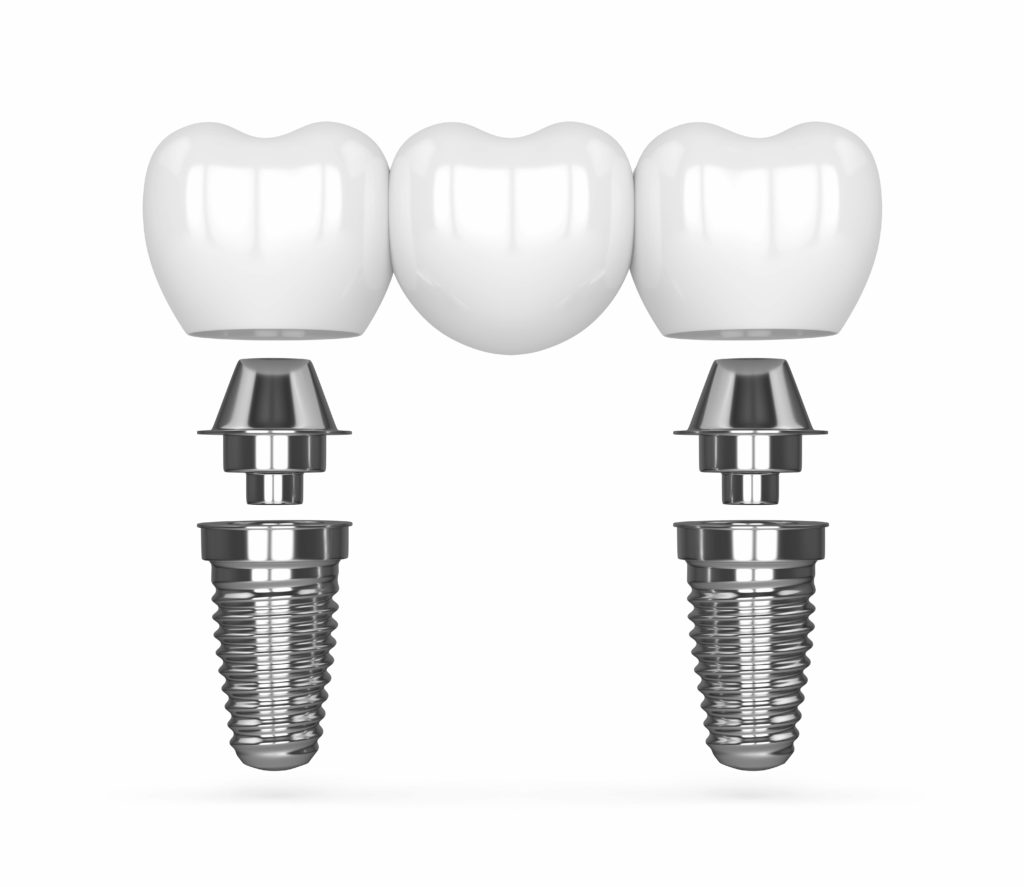

Dental implants are strong enough to support a variety of dental prosthetics. According to the American College of Prosthodontics, the most popular dental prosthesis is a dental crown. In fact, they estimate that around 2.3 million single implant-supported dental crowns are fabricated every year. Besides dental crowns, dental implants can also support dental bridges and dentures, meaning they can be used for a variety of restorative cases.

Dental implants also come in two different types. Endosteal implants are the most commonly used, so they are the type of implant that most people are familiar with. Endosteal implants are implanted into the jawbone. Subperiosteal implants are not as commonly used or as well known. Subperiosteal implants sit on top of the jawbone, rather than inside it. This allows dental implants to work for patients with different dental needs.

Dental implants also come in different sizes. In most cases, a standard sized implant is used. However, there are cases when either a wide or mini dental implant may be used. Wide dental implants are slightly larger in circumference than the standard size and are used when a dental prosthesis is being used to restore a molar. Mini dental implants are slightly narrower than a standard size and are used in tight spaces or when there is a lack of bone mass. Mini dental implants are often called MDIs or narrow dental implants. The range of sizes also allows dental implants to work for patients with different dental needs.
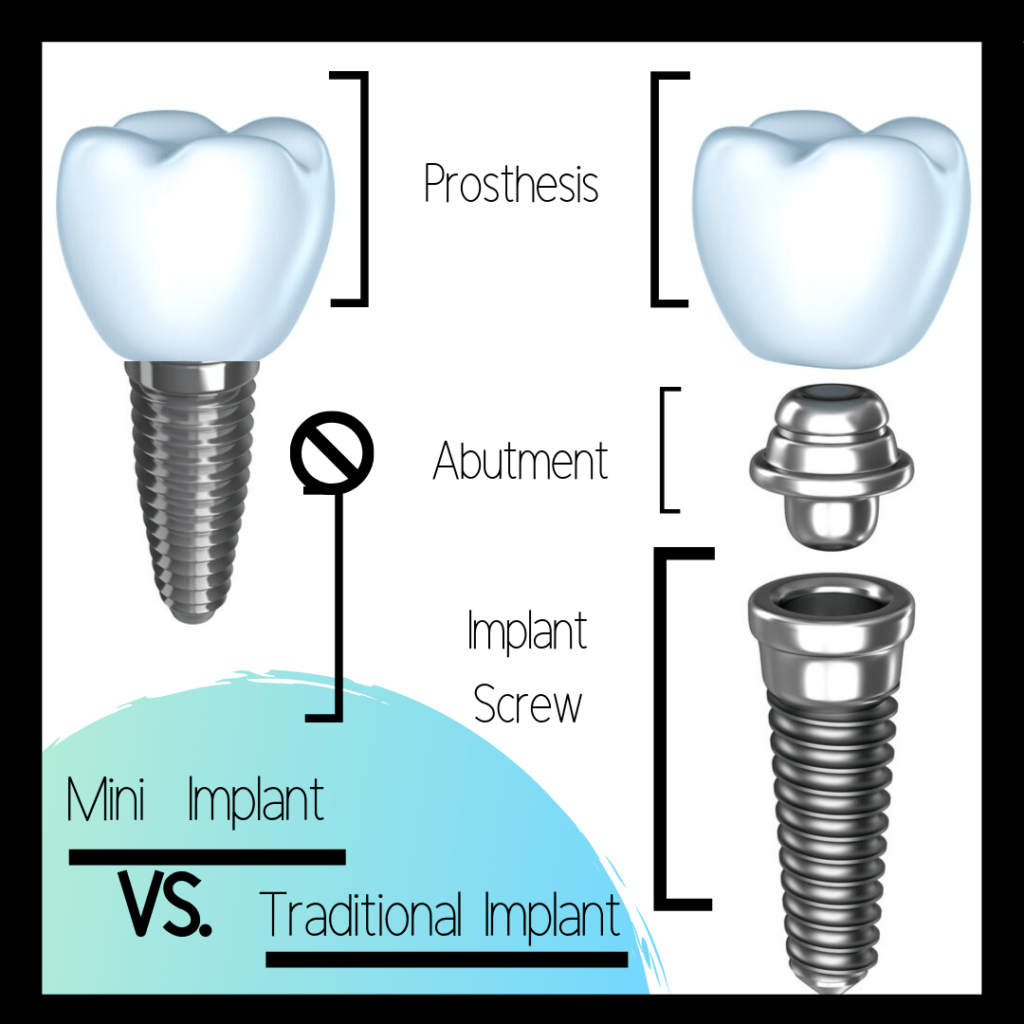

Just as implants come in different types and a range of sizes, their structure can also vary. For example, subperiosteal implants are made up of a metal framework that sits on the jawbone just below the gums. Endosteal implants, on the other hand, are composed of a titanium screw that is placed into the jawbone. Endosteal implants are available in different sizes that can affect their structure as well. Standard and wide dental implants are composed of three pieces: the implant screw, the abutment (connector), and the dental prosthesis. In MDIs, however, the connector and dental prosthesis are fused together, making MDIs only two pieces.

In most cases, dental implants can be placed in a single dental appointment. To place a dental implant, you can expect to be anesthetized and sedated to keep you calm and comfortable. A small incision will be made in your gums to access your jawbone. The existing tooth socket will then be shaped and the implant screw will be placed. Most likely, the abutment will also be connected and the gums will be sutured up around it. This means that the abutment will stick out above the gum line. In some cases, a second dental appointment is needed to uncover the implant screw and attach the abutment. For more information, see “Dental Implants”.
Check back next week for reasons 6-10 of why Dental Implants are the Best Restorative Treatment.

Dr. Anthony Mancino is Monmouth and Ocean County New Jersey’s General and Cosmetic Dentist and has been practicing for over 25 years focusing on cosmetic and overall dental health. Dr. Mancino is a graduate of Villanova University and University of Pennsylvania. He is also a member of the American Dental Association, New Jersey Dental Association, Monmouth & Ocean County Dental Association, American Academy of Cosmetic Dentistry, and the Academy of General Dentistry.


When you look in the mirror for the first time after having your teeth whitened, you will be blown away by your new smile. As a result, you will find yourself often smiling for no reason or smiling at everyone you meet. Not only will this brighten the mood of others around you, but it will make you feel happier as well.

Contrary to what most people think, teeth whitening does not remove the tooth’s enamel. In some cases, it can even actually help to preserve the enamel. People with whiter teeth are more likely to use proper brushing techniques that are beneficial to their oral health. On the other hand, people with discolored teeth often have a detrimental habit of brushing too hard in an attempt to remove the stains. Unfortunately, the stains will remain, but the enamel will begin to wear down over time. If continued, the gums will also likely recede, making the teeth look enlarged.

Many people who undergo teeth whitening report having higher self-esteem after seeing the results. Everyone deserves to feel good about themselves, especially if all it takes is a teeth whitening treatment. People who have higher self-esteem are more likely to be seen as successful, capable, trustworthy, and friendly. In the workplace, they are also more likely to be promoted.


It is no secret that smoking is detrimental to your overall health. Not only that, but tar and nicotine are two common sources of tooth stains and discoloration. While this will not work for every individual, some people are able to use teeth whitening as a way to help them quit smoking. Teeth whitening is a step in the right direction and some may be less likely to pick up a cigarette if they know it will undo the results. Because of this, some people view teeth whitening as an incentive to quit smoking or simply as a way of committing to quitting.

A natural part of aging causes our teeth to become more yellow in color as our enamel wears down and shows the dentin layer. Although wrinkles get a lot of attention as being indicators of age, tooth color is another common indicator that people don’t immediately think of. Teeth that are whiter and brighter make your entire face appear brighter and younger. Having white teeth also makes you appear younger because white teeth are a sign of youth.
Overall, there are many different reasons why you should get your teeth whitened and very few excuses not to. The procedure is fast, easy, and painless. The cost is affordable. The results are amazing and can be transformative for your self-esteem and social life. In some cases, teeth whitening can even help improve your oral and overall health. The question now is, what are you waiting for?

Dr. Anthony Mancino is Monmouth and Ocean County New Jersey’s General and Cosmetic Dentist and has been practicing for over 25 years focusing on cosmetic and overall dental health. Dr. Mancino is a graduate of Villanova University and University of Pennsylvania. He is also a member of the American Dental Association, New Jersey Dental Association, Monmouth & Ocean County Dental Association, American Academy of Cosmetic Dentistry, and the Academy of General Dentistry.
Are you looking for an easy way to improve the look of your smile? Do you want to avoid more involved methods like veneers or dental crowns? Have you been considered teeth whitening? As one of the most popular cosmetic dental treatments, teeth whitening has been successful for a variety of patients.
Professional teeth whitening is performed in a dental office or through the use of take-home trays. Both methods will have different results, so you will need to consult with your dentist to determine which is the best teeth whitening method for you. In some cases, professional teeth whitening may be performed in the office and take-home trays may also be given for later use.
At this point, you may be wondering why bother having your teeth whitened. However, if you are looking for an easy way to improve the look of your smile, teeth whitening may just be the perfect cosmetic dental treatment for you. Here are ten reasons why you should get your teeth whitened:
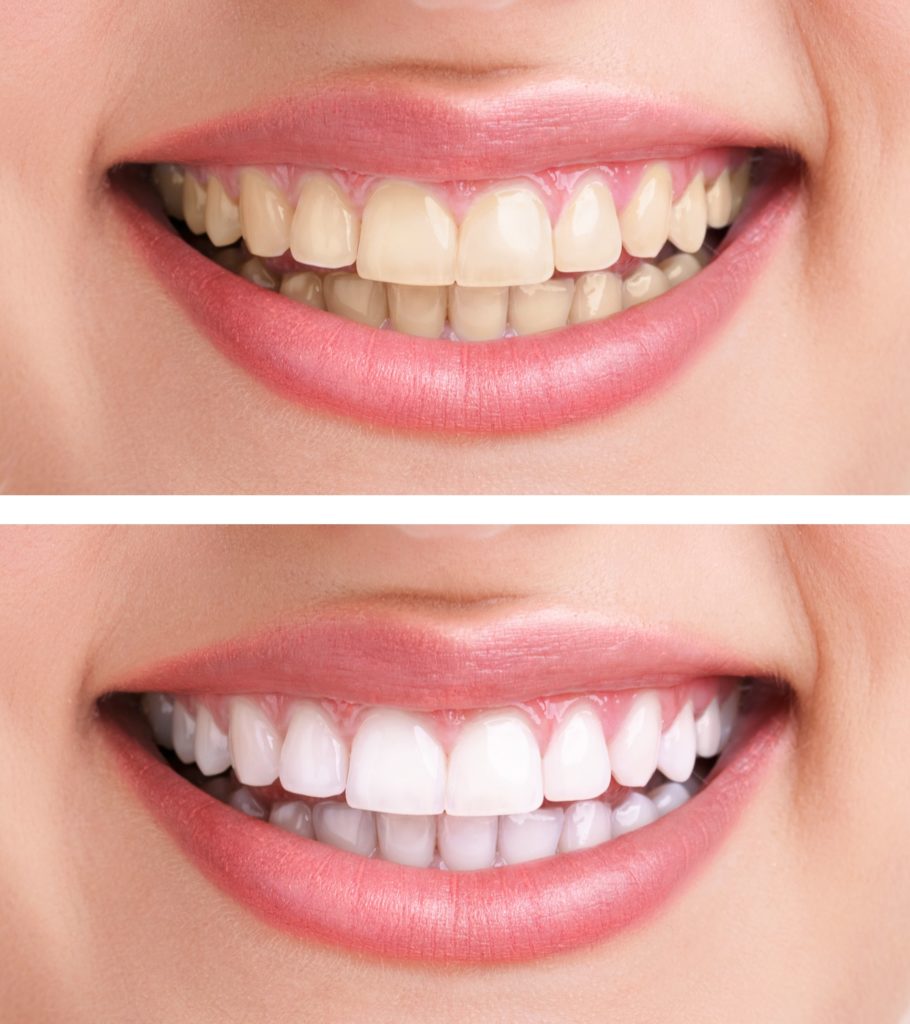

Professional teeth whitening procedures use a whitening agent that is absorbed by the enamel and dentin layers of the teeth. After being absorbed, the chemical compound of the whitening agent reacts with the discolored molecules and causes them to break apart. This process is what removes stains and discolorations from your teeth. Professional teeth whitening can remove the tough stains from diet, poor hygiene, medications, age, and smoking.

Teeth whitening is priced much lower than other cosmetic dental treatments. This is one main reason why it tends to be so popular. The actual cost will depend on the type of whitening treatment you opt for, but overall teeth whitening procedures are one of the most affordable cosmetic dental procedures.

Having your teeth professionally whitened takes very minimal effort on your part. Simply, lay down and relax while your teeth get whiter. Prior to placing the whitening agent, your teeth will need to be cleaned so that any plaque can be removed and the surface will be smooth. Your gums will also need to be isolated from your teeth to prevent them from being irritated by the whitening agent. The whitening agent will be brushed over the surface of your teeth and left in place while you relax. Once the procedure is over, your mouth will be rinsed.


In addition to being easy, the teeth whitening procedure is also fast. Most teeth whitening agents only need to sit on the teeth’s surface for 30-60 minutes to be effective. Even after the whitening agents are rinsed off the teeth, they will continue the whitening process for the next 24 hours. Only 30-60 minutes in the dental chair buys you 24 hours of teeth whitening.

The active ingredient in professional teeth whitening agents are either hydrogen peroxide or carbamide peroxide. Both these compounds are broken down into water while the whitening agent breaks the discolored molecular bonds. Since they become water after the whitening reaction has taken place, they can simply be absorbed into the body.
For more information on teeth whitening, see “Teeth Whitening” or Part II of “10 Reasons to Get Your Teeth Whitened”.

Dr. Anthony Mancino is Monmouth and Ocean County New Jersey’s General and Cosmetic Dentist and has been practicing for over 25 years focusing on cosmetic and overall dental health. Dr. Mancino is a graduate of Villanova University and University of Pennsylvania. He is also a member of the American Dental Association, New Jersey Dental Association, Monmouth & Ocean County Dental Association, American Academy of Cosmetic Dentistry, and the Academy of General Dentistry.

When having dental veneers placed, some people choose to get a single veneer, while others choose to get an entire smile makeover. What’s truly great about dental veneers is that you can do both with no problem. Once placed, the veneers will blend in with the shape, size, and color of your natural teeth. In this way, they will be completely indistinguishable from your natural teeth.

Your veneers will be custom fabricated to meet your individual dental needs and cosmetic goals. For example, thicker veneers may be placed to combat tooth sensitivity. Or your veneers may come in different sizes to make your unevenly shaped teeth look more uniform. Ultimately, the customization of veneers is what allows them to be used for such a large variety of dental concerns.

The actual lifespan of your veneers will depend upon the type and material of the veneer you chose. In most cases, composite and no-prep veneers tend to last about 5-7 years. Traditional porcelain veneers have a much longer lifespan and can last from 10-15 years, on average. However, there are cases where traditional veneers have lasted up to 20 years. To keep your veneers lasting as long as possible, you will want to take care when eating especially hard foods. It is recommended to chew with the back of your mouth to avoid damaging the veneers.

Unlike other types of cosmetic restorations, veneers are very easy to take care of. After they are placed, there is no recovery time and they require no additional care outside of your usual daily dental routine. Just be sure to brush twice a day for two minutes at a time with fluoridated toothpaste and floss once a day. And don’t forget those regular dental checkups and teeth cleanings every six months!

This is probably one of the biggest downsides of veneers. Most dental insurance companies will not provide coverage for veneers because they are classified as purely a “cosmetic” service, . However, there are a variety of financing options available. To give you an idea about the cost of veneers, traditional veneers average between $925-$2,500 per tooth, while no-prep and composite veneers range from $800-$2,000 per tooth.
Overall, dental veneers are one of the best cosmetic dental treatments available today. Many people have expressed high levels of satisfaction with their veneers. Now that you know a little more about dental veneers, you’ll be able to decide if they are the right cosmetic dental treatment for you.

Dr. Anthony Mancino is Monmouth and Ocean County New Jersey’s General and Cosmetic Dentist and has been practicing for over 25 years focusing on cosmetic and overall dental health. Dr. Mancino will artistically transform your smile, often in just two visits. Schedule a consultation today!
If you are considering cosmetic dentistry, it is very likely that you have heard about dental veneers. In fact, many Hollywood celebrities have used dental veneers and have helped to raise their popularity.
Dental veneers are thin shells that are adhered to the front surface of your teeth. They are known as a cosmetic dental treatment because they work to improve the overall aesthetics of your smile. However, there are many other things that you probably don’t known about veneers.
To help you decide if dental veneers are the best cosmetic dental treatment for you, here are 10 interesting facts about dental veneers:

To place dental veneers, your dentist will first need to remove a tiny amount of enamel from the front of your tooth. This ensures that the veneer will fit smoothly over your tooth while maintaining a natural appearance. If needed, dental anesthetics can be used to keep you comfortable. For more information, please see our Veneer service page.

Dental veneers are highly versatile and can fix multiple dental concerns all at once. Veneers can fix: chipped, cracked, discolored, misaligned, worn, or oddly shaped teeth, as well as teeth that have gaps between them. Ideal candidates for veneers are those individuals looking to improve the look of their smile through correcting cosmetic concerns. However, to be a candidate for veneers, you must be free from tooth decay and gum disease.

The two types of veneers include traditional veneers and no-prep veneers. Traditional veneers are thicker and require the removal of more enamel to be placed. No-prep veneers, on the other hand, are ultra-thin and require minimal to no preparation. Because both types of veneers have their pros and cons, you will need to discuss these with your dentist to decide which type is best for you.

Veneers can be made from either dental composite or porcelain. Both materials are strong and can be colored appropriately to match or enhance your tooth color. Dental composite is easier and faster to place, requires less enamel alteration, and is more affordable. However, it does not last as long as porcelain. Porcelain has a highly aesthetic and natural appearance, is stain resistant, and is highly durable. Porcelain is also more expensive than composite.

Veneers are placed on the front side of your tooth. This causes them to act like a shield, protecting your teeth from the stimuli that causes tooth sensitivity. In fact, some people get dental veneers to alleviate their tooth sensitivity. Additionally, by repairing worn or broken enamel, veneers make your teeth stronger overall.

Dr. Anthony Mancino is Monmouth and Ocean County New Jersey’s General and Cosmetic Dentist and has been practicing for over 25 years focusing on cosmetic and overall dental health. Dr. Mancino will artistically transform your smile, often in just two visits. Schedule a consultation today!

Do you currently have multiple missing, decayed, or damaged teeth? Are you currently wearing dentures, but are tired of them slipping and interfering with your speech? Do you wish there were a more permanent solution to replacing missing, decayed, or damaged teeth?
Currently, the American College of Prosthodontists estimates that 120 million Americans are missing at least once tooth and that about 36 million Americans are missing all their natural teeth. Tooth loss can occur for many reasons including tooth decay, gum disease, smoking, teeth grinding, certain medications, age, genetics, and certain medical conditions.
If you answered “yes” to any of the above questions, or if you are one of the 36 million Americans considering a full mouth reconstruction, then implant-supported dentures may be the answer you’ve been waiting for. Implant-supported dentures sometimes referred to as “All-on-Four or All-on-4” implants, are dentures that are rooted in place using dental implants.
Similar to dentures, they can restore an entire upper and/or lower arch. Unlike dentures, however, implant-supported dentures do not slip or interfere with speech. Additionally, implant-supported dentures will not rub against the gums like traditional dentures do. But perhaps the greatest benefit of implant-supported dentures is that they stimulate the jawbone. Unfortunately, because traditional dentures sit on top of the bone instead of within the bone, they do not stimulate the jawbone.
To stay healthy, the jawbone needs to be stimulated by the forces of chewing and biting. Without this stimulation, the body starts a process called bone resorption. This occurs approximately six months after a tooth or multiple teeth are lost. Bone resorption is the process by which the calcium is absorbed back into the body and the jawbone begins to breakdown. Over time, this process will cause the bone to change shape.
Because implant-supported dentures provide the jawbone with stimulation, they can restore missing, decayed, and damaged teeth all while preserving the natural underlying bone structure. For this reason, Dr. Mancino strongly recommends implant-supported dentures over traditional dentures for most patients. However, for treatment to be successful, the patient in question must have adequate bone mass to support multiple dental implants.
To determine if there is enough bone mass present, Dr. Mancino will likely obtain a CBCT scan. CBCT stands for cone-beam computed tomography, which is a specialized type of x-ray. A CBCT scan rotates entirely around the head and generates 150-200 individual 2-D images that are then compiled digitally into a single 3-D image. This 3-D image shows teeth, soft tissues, nerve pathways, and bone in a single image. The scan itself only takes about 20-40 seconds and emits very minimal radiation.
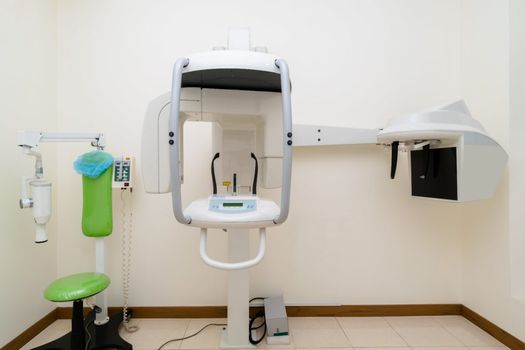
To maintain bone mass, it is important to pursue the placement of implant-supported dentures sooner rather than later if you have missing teeth. If you have teeth that are severely decayed or damaged, these teeth will need to be extracted before the placement of dental implants. To avoid bone loss, it is often beneficial to have implants placed immediately following an extraction.
In cases where bone loss has occurred, other procedures may be used to build up bone mass. The most popular procedure is called a bone graft. During a bone graft, bone material is placed in areas of low bone mass. In about 3-6 months, this bone material grows new bone in this area. Another procedure is called a sinus lift. A sinus lift is a specialized bone graft that is performed on the upper jaw to build up the thickness of the bone between the teeth and the sinus cavity, essentially “lifting” the sinus cavity. Both procedures allow for the safe placement of dental implants.
Once it has been determined there is adequate bone mass in the treatment areas, implant-supported dentures can be placed. This process starts with the placement of approximately 2-6 dental implants in the affected arch. In the case of a full-mouth restoration, 2-6 dental implants will be placed in the upper arch and an additional 2-6 implants will be placed in the lower arch.
To place a dental implant, a small incision will be made in your gums at the implant site. Then the tooth socket will be cleaned and shaped for the implant screw. The implant will then be screwed into place and the abutment, or connector, the piece will be attached. The abutment shape can vary depending on the type of denture being used.
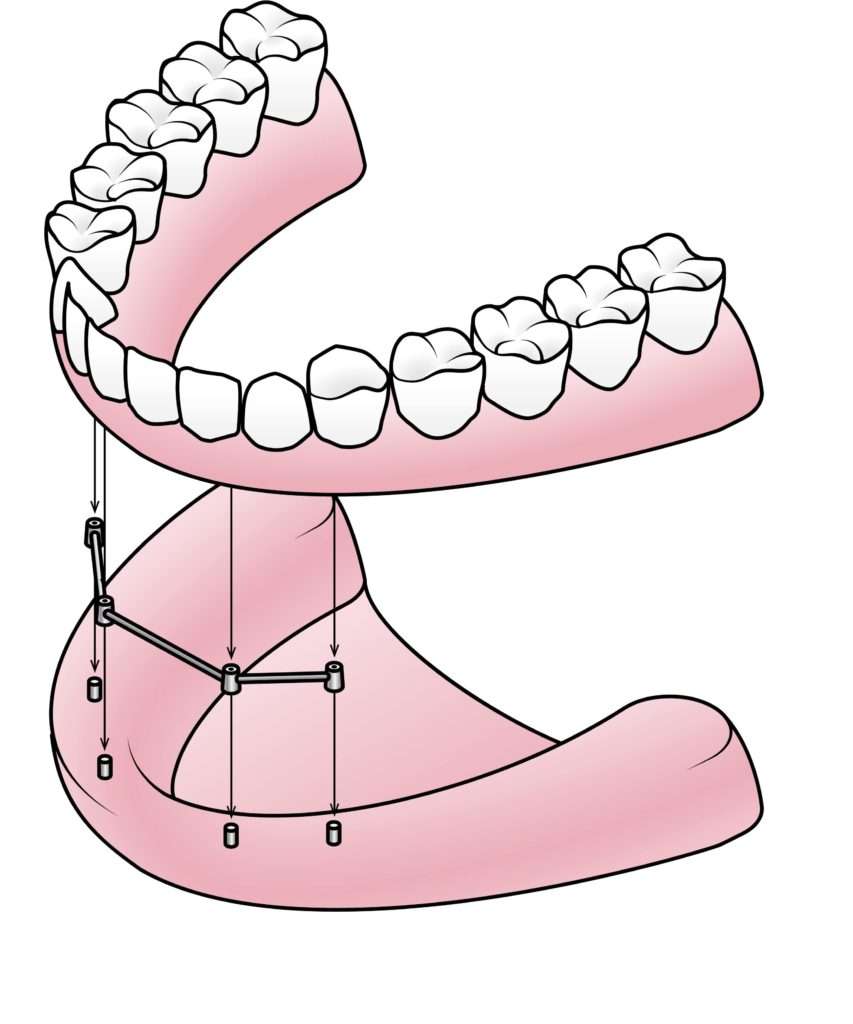
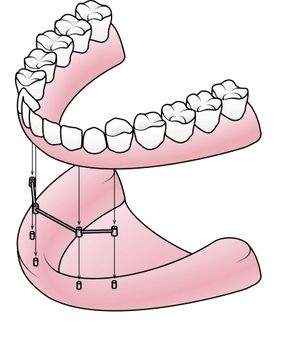
There are two types of implant-supported dentures: bar-retained and ball retained. Bar retained implants require less dental implants and are supported by a single bar that clicks into the abutments. Ball retained implants, on the other hand, require more dental implants, but attach to these implants using a ball and socket attachment. During your consultation, which type is best for your case will be discussed.
Once the implants and abutments are in place, the denture can be placed. In some cases, a temporary denture will be used and in others, the permanent restoration may be placed at this time. When the permanent restoration is placed, it is called immediate load dental implants or teeth in a day implants.
Although they are called immediate load implants, your implants will still need time to heal before they can handle the full force of chewing and biting. For this reason, you will be placed on a temporary soft food diet until osseointegration occurs. Osseointegration is a process where the implants fuse with the surrounding bone. For treatment success, osseointegration must occur to secure the implants in place.
Along with a temporary soft foods diet, there will be additional post-operative instructions that you must follow to guarantee the best treatment outcome. With implant-supported dentures, patient compliance is an important part of a successful recovery. Specific post-operative guidelines can vary, but generally, they revolve around taking antibiotics, keeping the treatment area clean, and attending post-op appointments.
Additionally, you will need to avoid damaging behaviors and maintain proper daily hygiene. Damaging behaviors are things like smoking, ice or pen chewing, nail-biting, and using your teeth to open packages. Also, if you grind your teeth, you may need to wear a special dental appliance called a mouthguard to protect your denture and your implants while they heal. Proper daily oral hygiene will consist of brushing your dentures with a soft toothbrush and denture detergent after removing them every night. You will also need to gently brush the areas around the abutment to keep these areas clean as well.
If properly cared for, implant-supported dentures can last for several years. The exact lifespan of implant-supported dentures is hard to say because there are three pieces you need to consider. The dental implants last the longest and can last up to 20 years, although most last for about 10-15 years. The denture piece, however, only lasts for about 8 years. Finally, with a bar-retained denture, attachments will need to be replaced every 6 months to a year. However, replacing the denture and attachment pieces are relatively easy.
Are you interested in seeing what implant-supported dentures can offer you? For the best cosmetic dentist in Wall, NJ, schedule a consultation with Dr. Anthony Mancino of Comprehensive Dentistry today! Comprehensive Dentistry is also proud to serve residents in Monmouth and Ocean Counties.

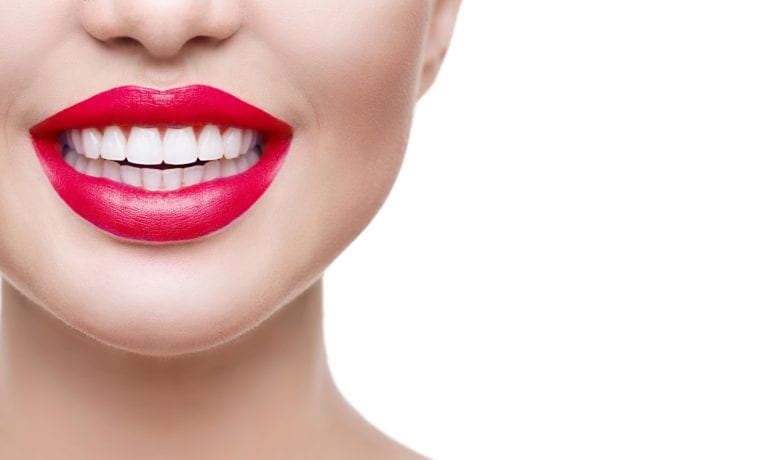
Having a great smile is highly important to many people. So important that a recent study found that about 48% of Facebook users removed themselves from tagged photos because they did not like their smile. In general, most people consider themselves and others to be more attractive when they are smiling.
However, for people with less than perfect teeth, smiling may produce anxiety and embarrassment that causes an individual to smile less. Because smiling has a host of benefits, these individuals are missing out by not smiling more.
Luckily, modern dentistry has developed a variety of cosmetic dental treatments that can alter the size, shape, color, spacing, and alignment of imperfect teeth to enhance the visual aesthetics of one’s smile. Depending on the specific imperfections a person would like to correct, they can choose from cosmetic dental treatments such as:
Although cosmetic dental treatments are primarily known for their ability to improve the appearance of one’s smile, they are also used to restore missing, damaged, or decayed teeth to their former state. In fact, if you look at the above list of cosmetic dental treatments, you may realize that there is a definite overlap between cosmetic dental treatments and restorative dental treatments.
Both cosmetic and restorative dental treatments are very similar, however the main difference between the two is that restorative dental treatments are focused on restoring only the function, while cosmetic dental treatments restore both the function and the visual appeal. Because of this, cosmetic dental treatments offer many health benefits, including:
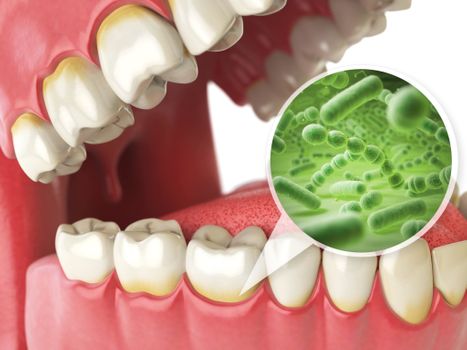


Are you interested in seeing what cosmetic dentistry can offer you? For the best cosmetic dentist in Wall, NJ, schedule a consultation with Dr. Anthony Mancino of Comprehensive Dentistry today! Comprehensive Dentistry is also proud to serve residents in Monmouth and Ocean Counties.
After-Hours Emergencies Or Issues
Call 732-556-9600
Our Services
Dental Emergencies
General Dentistry
Cosmetic Dentistry
Restorative Dentistry
Full Mouth Reconstruction
Smile Makeover

3350 Route 138 W
Bldg 2, Ste 127
Wall Township, NJ 07719
(732) 556-9600
 3350 NJ-138 W. Bldg 2, Ste 127, Wall Township, NJ 07719
732-556-9600
Prices Vary
Comprehensive Dentistry -
5 star rating - based on 25+ reviews in Google
3350 NJ-138 W. Bldg 2, Ste 127, Wall Township, NJ 07719
732-556-9600
Prices Vary
Comprehensive Dentistry -
5 star rating - based on 25+ reviews in Google
